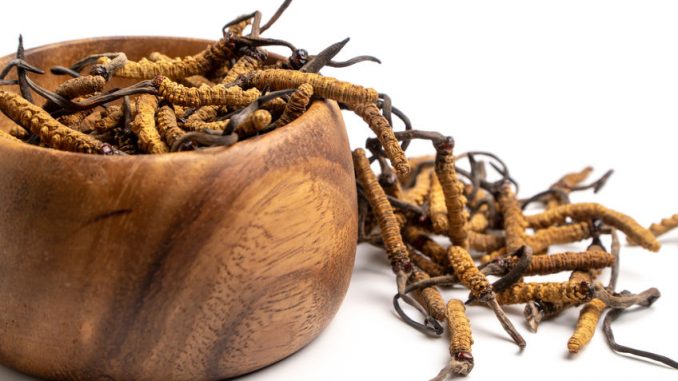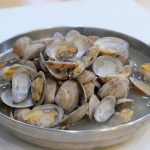
Cordyceps sinensis (Berk.) Sacc. (family Clavicipitaceae) which is also known as winter worm or summer grass also means Dong-Chong-Xia-Cao in China. It is an important traditional Chinese herbal medicine. Cordyceps are particular types of macrofungi that have a characteristic parasitic habit on larvae and pupae of insects (Winkler, 2008).
As well as being an important component in Chinese traditional medicine it is also a key material in Tibetan medicine and especially in Sikkim.
A few studies are now available which have characterised the key components in this fungus.
The Fungus
The scientific name is Cordyceps sinensis (Berk.) Sacc. (family Clavicipitaceae). C. sinensis infects the larvae of the sphinx moth, Hepialus armoricanus. This is found only in the highlands of the Himalayan region such as Sikkim, and the larva hibernates underground through the winter.
The fungus kills the infected larva and grows through its cadaver casing in the summer. The normal harvesting period stretches from April to August. The rod shaped stroma grow out of the mummified shell and these are collected to make the medicine (Feng et al., 2017).
The fungus is often cultivated on this larvae but there are now methods to ferment using submerged technology suited to fungal growth (Wu et al., 2015).
A number of different strains of this Cordyceps are now available for commercial exploitation. Those strains which are fermentable have a similar chemical composition and produce similar pharmacological compounds to the fungus which parasitizes the larvae (Chen et al., 2014).
Various pharmacological benefits have been reported. It has traditionally been used to treat a variety of illnesses, promote longevity, relieve exhaustion and increase athletic prowess. The key conditions treated are:-
- immunomodulatory disease
- various cancers and tumours (Kim et al., 2016; Ji et al., 2015)
- diabetic conditions
- treatment of chronic hepatitis and kidney failure
Whilst these cover a wide range of conditions the clinical evidence for thee long held traditional uses has yet to be established. However, the compounds found in the fingus are fascinating and may well have considerable pharmacological benefits in their own right.
To date, the products on the market which are from fermented Cordyceps sinensis are mainly Jinshuibao capsules, Jinshuibao tablets, Bailing capsules, Ningxinbao capsules, Xinganbao capsules, and Zhiling capsules. These are all prepared using different strains of the species (Wu et al., 2017).
Componentry Of Cordyceps sinensis
- -cordycepin (Cunningham et al., 1951)
- -ophicordin which is an antifungal compound.
- various sterols with antitumour capability (Bok et al., 1999).
- various nucleosides not all of which have been identified or characterised (Cheng et al., 2017).
The sterols are perhaps the most intriguing. One of them is ergosterol. This is a key precursor in vitamin D2 synthesis where the sterol is converted by ultraviolet light to this hormone.
Anti-Aging Properties
In China and Taiwan, the elderly have traditionally taken Cordyceps of many types to reduce tiredness and fatigue, to boost their libido and reduce their weakness. It is not clear which component or components may be responsible but these users set great store by the product.
Some of the benefits are possible down to the reasonably high antioxidant potential of the compounds but that doesn’t explain it all. There are some studies with mice which indicate that C. sinensis improve sexual function.
References
Bok, J. W., Lermer, L., Chilton, J., Klingeman, H. G., & Towers, G. N. (1999). Antitumor sterols from the mycelia of Cordyceps sinensis. Phytochemistry, 51(7), pp. 891-898 (Article)
, , & (2014). Identification of nucleosides and nucleobases from cultured cordyceps militaris. Nature Product Communications, 9(5), pp. 637– 638 (Article)
, , & (2017). Determination and comparative analysis of 13 nucleosides and nucleobases in natural fruiting body of Ophiocordyceps sinensis and its substitutes. Mycology, 8(4), pp. 318– 326
Cunningham K.G., Herchinson S.A., Manson W., Spring F.S. (1951) J. Chem. Soc. 2299.
, , & (2017). Potential molecular mechanisms for fruiting body formation of Cordyceps illustrated in the case of Cordyceps sinensis. Mycology, 8(4), pp. 231–258. (Article)
, , & (2015). Effects of fermented mushroom of cordyceps sinensis, rich in selenium, on uterine cervix cancer. Evidence‐Based Complementary and Alternative Medicine, 5(1), 173180
Li SP, Li P, Dong TT, Tsim KW. (2001) Antioxidant activity of different types of natural Cordyceps sinensis and cultured Cordyceps mycelia. Phytomedicine. 8 pp. 207–12
Tsuno A, Taketomo N, Hiroyuki I. (1995) Healthful composition obtained from the hot water extract of Cordyceps sinensis mycelia. J. Lab. Clin. Med. 8 pp. 134–7
Winkler, D. (2008) Present and historic relevance of Yartsa Gunbu (Cordyceps sinensis).An ancient myco-medicinal in Tibet. Fungi. 1 pp. 6–7. .
, , & (2015). Effects of fermented Cordyceps sinensis on oxidative stress in doxorubicin treated rats. Pharmacognosy Magazine, 11(44), pp. 724–731 (Article)
, , & (2017). Research progress on quality standards of fermented Cordyceps powder products. China Journal of Experimental Traditional Medical Formulae, 23(20), pp. 220–227 .

Leave a Reply